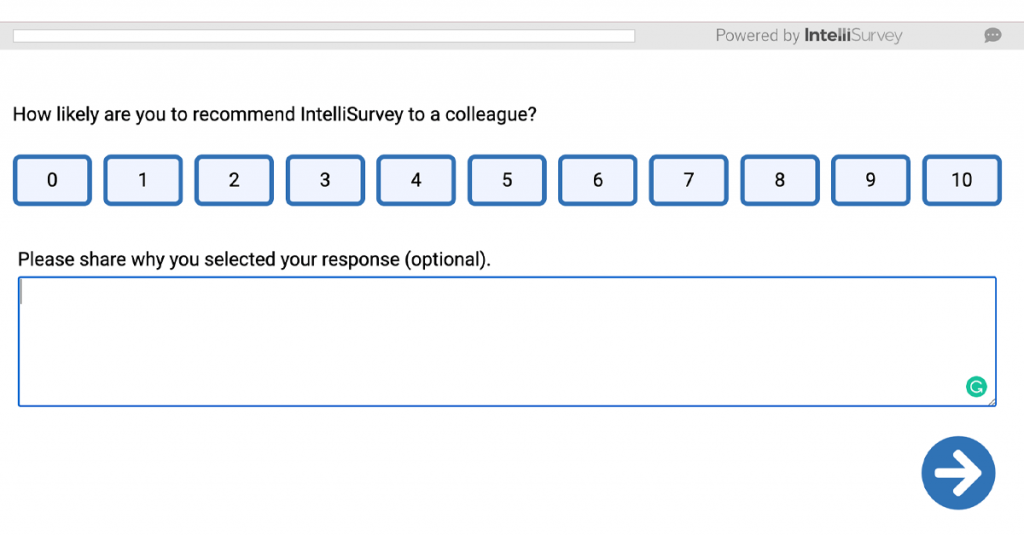Voice of the customer (VoC) helps organizations leverage feedback to improve how they interact with...
Create a Successful Net Promoter Score (NPS) Program in 8 Steps | IntelliSurvey
The beginning of the third quarter is when many businesses roll out their mid-year Net Promoter Score (NPS) programs. I’ve established and managed twice yearly and annual NPS programs at several companies in my career and have learned a lot about what works and what doesn’t. And I’ve learned from some missteps along the way!
What is an NPS Program?
An NPS program is a regular cadence of measuring how well a brand's relationship with its customers generates customer loyalty. In 2003, a partner at Bain & Company created the concept of NPS.* Bain & Company defines NPS as “a single, easy-to-understand metric that predicts overall company growth and customer lifetime value.”**
Whether you’ve been tracking your company’s NPS for years or you’re just getting started, this guide will teach you how to conduct an NPS survey and help you establish a consistent program to increase your response rates.
If you're looking to track your customer loyalty, increase customer satisfaction, and/or reduce churn, follow this guide to run a quick, recurring NPS survey, effectively reach your customers, and understand and act on their feedback.
Why Are NPS Programs Important?
A Net Promoter Score program can provide a holistic understanding of customer loyalty and satisfaction. In addition to providing quick and simple benchmarking across industries, these programs can identify areas for improvement and help forecast business growth.
Furthermore, NPS programs help employees understand how their performance directly impacts customer satisfaction and NPS scores. They can then perform proactive issue resolution by identifying dissatisfied customers early on and promptly following up with detractors.
How to Build an NPS Program
Step 1: Decide what needs an NPS score
The first thing to consider is what exactly you want to track NPS for. Are you tracking it for a product group, individual product lines, certain services, or your brand? Theoretically, you can track NPS for any and all of those items, but be sure to consider your team’s bandwidth to execute more than one NPS program. More importantly, if your customers use more than one product or service, your response rates will likely suffer and customers may unsubscribe if they feel spammed by constant requests, especially if they seem duplicative. You also run the risk of customers getting confused about what they’re rating.
In my experience, it’s best to focus on one area, such as your brand.
Step 2: Build your list
Whether you use a customer relationship management (CRM) tool like Salesforce, HubSpot, a homegrown tool, a spreadsheet, or any other number of options, make sure you have a complete and clean list. That list should be ready to export into whatever tool or email system you use to send your NPS survey.
If you’re going to personalize your emails, make sure your list includes correctly spelled (and capitalized) names. There’s nothing worse than when I receive a “personalized” email and my name is misspelled or not capitalized. This can be time-intensive, but the cost of disappointment and lost trust in your email outweighs the time it takes to scan through your list.
Most importantly, make sure you have permission to email your contacts. Check local, state, and federal regulations to make sure you are in compliance with laws like the California Consumer Privacy Act (CCPA), California Privacy Rights Act (CPRA), General Data Protection Regulation (GDPR), and other applicable laws.
Step 2B: Draft your NPS survey
This is step 2B because ideally, this is a two-question survey:
- How likely are you to recommend our [business/product/service] to a [friend/family member/colleague]?
- Please share why you selected your response (optional).
Make sure you provide a 0-10 point scale where 0 is “very unlikely” or “not at all” and 10 is “very likely” or “definitely.”

Having an open field text response for people to provide context for their answers can be extremely helpful during analysis and for account managers to customize their follow-up activities.
If for some reason you absolutely must include additional questions, keep them short and to a minimum.
The sole focus of your NPS program should be measuring NPS and adding extra questions is very likely to decrease your response rates. Try to save your other questions for a different survey at another point in time.
Step 3: Establish workflows and communicate them internally
You’ll need various departments within your company to buy into the NPS process for it to be successful. Account management, customer success, and even sales should complement automated marketing emails with personal outreach to request their contacts complete the survey.
Be sure to think through what happens once someone completes the survey:
- Should they get an auto-email from marketing thanking them for responding?
- Should the respondent’s POC at your company reach out personally?
- If they responded as a promoter (scored a 9 or 10) are you going to ask them to be a reference customer for future sales? Do they receive something extra like a thank you gift?
- What happens if they respond as a detractor (scored 0-6)? Should they receive an immediate, custom response to uncover the issues?
- What happens for respondents that are passives (scored a 7 or 8)? Will you put a program in place to win them over?
Make sure the responses you define align with your brand and you think through all possible scenarios.
Communicate expectations and timelines internally and make sure everyone understands what they’re supposed to do and when. Hosting a brief, recorded training session is always helpful. And be sure to keep your internal teams updated throughout the entire process.
Step 4: Draft your communications
It can take numerous attempts to get someone to respond to even a one-question NPS survey. Write multiple emails that will come from your marketing or email automation tool and have internal teams complement email efforts by sending personalized messages via phone, text, and their own email.
Pro tip: Be sure to provide those making any personal outreach efforts with talking points and sample emails.
Plan to send messages every week or two for 6-8 weeks depending on your audience engagement levels and response rates.
Use this as an opportunity to test different subject lines, different email body copy, and even different call-to-action (CTA) buttons. If your email tool allows you to, conduct A/B testing of subject lines and email body copy to see what works best. Then adapt future messages from those results.
Try testing out subject lines like “{First name}, answer one question for us please?” or “{First name}, tell us how we’re doing!” or “Take our one-question survey.” Depending on your audience, corporate tone, and what email tool you’re using, you could even add emojis to your subject line to grab attention. Here are some of my favorites: 👋👂🗣✅
CTA button examples include: “Answer 1 Question”; “30-second Survey”; “Take the Survey”; “Share Your Feedback” and so on.
Make sure your final emails clearly state “last chance” in the subject line, email body, or both!
Don’t forget that your email drafts should include any follow-up messaging identified in your workflow exercise.
Step 5: Select your tool and launch
There are numerous ways to launch an NPS survey. Free tools, and free trials, are available as well as workarounds like coding a form onto a landing page for your website. Having managed NPS at past companies, I’ve gone a few different routes. If your budget allows, I highly recommend using a company with a survey tool that is already set up to accommodate NPS which helps you expedite your survey and guides you to get the best results. Here at IntelliSurvey we do everything from basic surveys, such as NPS, all the way to extremely nuanced and complex surveys (more on that in a future post). If you’re interested in furthering your market research program beyond NPS, using one company to support all of your research efforts makes it a simple and seamless process.
No matter what tool or workaround you select, give yourself some lead time to get familiar with the features and functionality and time to test and make sure there are no hiccups. Make sure all the reporting you will need is available too!
Once you’re comfortable with the tool and have your list uploaded, your question and response scale ready, and your emails prepared to launch, send one last reminder to your internal teams and let them know you’re hitting GO!
Step 6: Monitor results
Make sure you’re tracking your email open and click-through rates (CTR) and see how that compares to the number of complete responses you’re getting on your survey.
If you did any A/B testing, make sure you optimize future messages based on those results. And ensure any automatic triggers you may have put in place are working (e.g., alerting account managers for detractor and/or promoter responses).
Step 7: Calculate your NPS score
Your target completion rate should be based on the typical engagement you have with your audience, but for past NPS programs I’ve run, I try to hit the 80% completion mark. Try for a minimum of 60% so you at least get more than half of your respondents.
Once you’ve run through your pre-defined timeline or schedule and/or hit your completion goal, it’s time to calculate the results!
Calculate your NPS score by subtracting the percentage of detractors (those that score you from 0-6, are unsatisfied, and will recommend against your company) from the percentage of promoters (those that score you a 9 or 10, are extremely happy, and will recommend you to their peers). The passives (those that score you a 7 or 8) are excluded from the calculation because they don’t feel strongly one way or the other; which is really a whole separate issue.
NPS Score Scale Example

For example, if you surveyed 100 customers, and 75 were promoters and 20 were detractors, you would calculate this as:
NPS = 75% – 20% = 55
Note, even though you are subtracting percentages, your final NPS number – in this case 55 – is not a percentage.
What’s a good NPS score? Bain & Company (who created NPS) say:
- Above 0 is good
- Above 20 is favorable
- Above 50 is excellent
- Above 80 is world-class
For benchmarking and other score-related information, see this helpful article from Bain & Company.
Step 8: Analyze the data
See if you can make any correlations based on the data:
- Are new customers falling into one bucket more than another?
- Are customers in a particular vertical happier or unhappier?
- Are there any regional differences?
- Are customers with one particular account or customer success team happier than others?
There are a million different ways you can slice and dice data depending on how robust your database is. Looking at the data in different ways helps you make educated business decisions to improve customer experience, retention, and ultimately profits. But it’s also ok to look just at the basics; especially when you first start out, and build from there.
To sum it up, NPS is a powerful metric every business should be tracking. How often you track it is entirely up to your business needs and your audience’s engagement. I say twice a year allows you to keep a thumb on the pulse of your customers and also see if there are any differences in seasonality. Some businesses do it quarterly and that can be great too. Again, it all depends on your audience and your NPS goals. We have over 20 years of experience here at IntelliSurvey conducting all sorts of surveys with, and on behalf of, clients- including countless NPS surveys. We’re total survey nerds and would love to chat about your NPS program!
Best Practices for an NPS Survey
Creating an NPS survey involves careful planning and consideration. These best practices can help you design and implement an effective NPS survey.
- Keep it simple and straightforward - avoid complexity or lengthy explanations
- Use a clear scale - the scale should be labeled clearly, with 0 being “Not at all likely” and 10 being “Extremely likely”
- Avoid leading questions - use neutral questions to avoid influencing a respondent’s answers
- Include an open-ended question - allow respondents to share their reasoning behind the score
Sources:
**Bain.com




